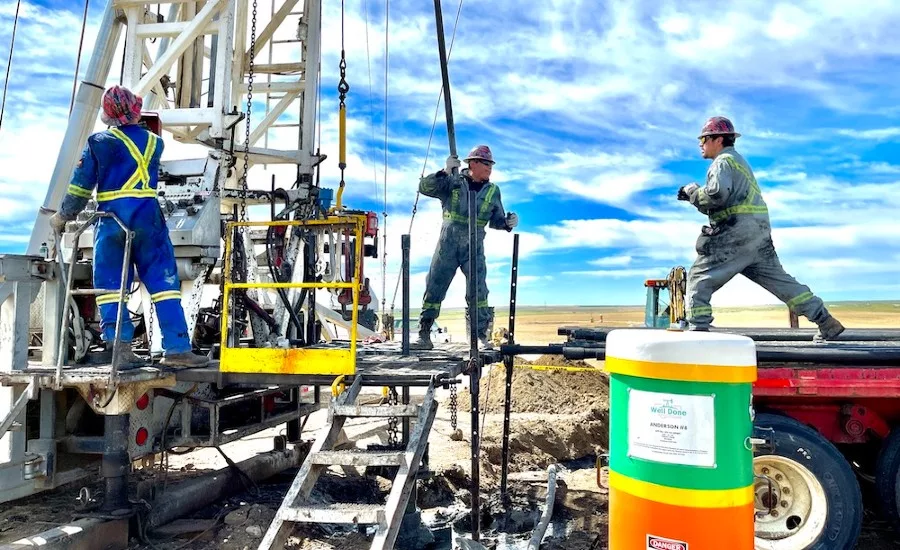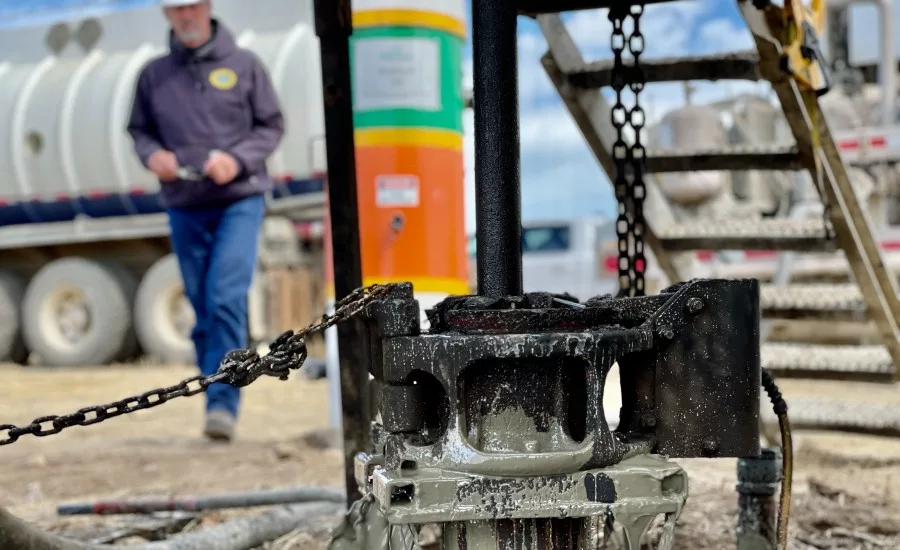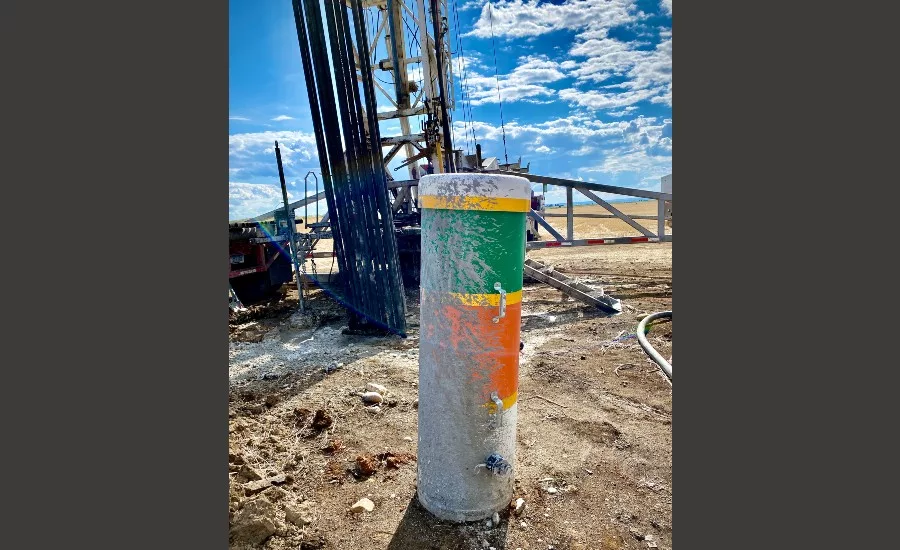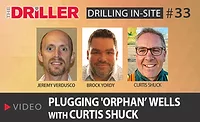Well Done Foundation Works to Plug ‘Orphan’ Oil & Gas Wells
Non-Profit IDs Abandoned Wells, Works Stop Methane Emissions

The Well Done Foundation has a mission to plug every “orphan” well in Montana — and beyond.
Source: Curtis Shuck

From start to finish it can take months to plug an orphan well. Much of that work, from research to stakeholder negotiation to testing and monitoring, coming long before drillers ever get involved.
Source: Curtis Shuck

The Well Done Foundation operates as a non-profit, seeking donations and corporate sponsorships to help properly secure abandoned wells.
Source: Curtis Shuck
Businesses don’t always succeed, and when one holding oil & gas assets fails, it can leave behind potentially dangerous wells. Seeing some of these wells in northern Montana inspired Curtis Shuck, in 2019, to launch the Well Done Foundation, a non-profit with a mission to plug every “orphan” well in Montana and beyond.
“The whole continuum from start to finish can be anywhere from 12 to 9 months in time,” says Shuck, chairman and CEO. “The plugging end of it? Two days at the very end.”
Much of the work comes in identifying wells, research, negotiation with stakeholders, testing and monitoring, and site restoration, he adds.
“What’s exciting is that those are some of the new jobs that we’re creating in this space. We’re still going to use oil & gas professionals to do the work at the end of the day, but now we’re creating this whole new classification, if you would. That’s what we’re excited about, is being able to bring these teams on line in these various locations.”
As of August 2021, the group had plugged eight wells with a ninth in progress, and had expansion projects underway in Pennsylvania, Louisiana and several other states. Nine wells may not sound like a lot when the EPA estimates the number of orphan wells in the United States to be about 3.2 million. However, plugging even one leaking, decades-old well can prevent thousands of tons of methane from escaping into the atmosphere.
We had Shuck on our Drilling In-Site video and podcast series to talk about the foundation, how it works and how others can get involved. This is an edited summary of our talk. Click here to see the full video, or here to listen to the podcast.
Q. Tell us about Well Done Foundation. Who are you and what do you do?
A. The Well Done Foundation and the Well Done name came as a bit of an epiphany after I encountered my first orphan well up in northern Montana. … I just couldn’t believe my eyes, what I saw and what I smelled. Initially, it was the visual impact of what was left behind by the industry. For me, it was something that was just unthinkable, that for anybody in any universe that it’d be OK to walk away from something like that.
That night, as I drove from Shelby, Montana, back to Bozeman, which is where I was living at the time, over the four-hour drive I could just not get this image out of my head of what I saw. Then, as soon as you see one, you start to recognize all of the others that are in the area. … It was one of those midnight drives, and I felt compelled that it was sort of my time to do something. It’s funny when you have those inflection points where you can either go right or go left. I guess I could have just pretended I never saw it and kept going on my merry way, but I really felt passionate that this was something that I needed to at least explore further.
At that time, the Well Done name was envisioned. On that trip home, I was securing domain names and mapping out this whole strategy. By the time I got back home that night in Boseman about 2 in the morning, I had already white-boarded out where we were going and the rest is sort of history now.
Q. How does WDF define an “orphan” well and how does a well become orphaned?
A. Each state typically maintains a list of orphan wells. The criteria varies a bit. But essentially an orphan well is this: An orphan well is a well that no longer has a financially viable, responsible party at the table. What happens is that those wells essentially become wards of the state. Through the transitions of business and the comings and goings, the last guy in line wasn’t able to continue to maintain it. So he had to forfeit his bond or whatever financial assurance vehicle he had in place and walk away. Then they just become the responsibility of the respective states. That’s the true meaning. ... In general, it’s those wells that no longer have a financially responsible party at the table.
Q. Walk us through what you call the Well Done Process. Once you identify an orphan well, what are the next steps?
A. Once we identify an area — a potential well, a candidate well — the first thing we do then is to go to work with the surface owner. Many states have what’s referred to as “split estate,” where the surface owner and the mineral rights have been bifurcated, so two different parties have ownership interest. Because the Well Done Foundation never takes an interest in the minerals — so we’re not producing these wells — our dealings are strictly with the surface owner for access. We work with the surface owners to develop an access program. Our experience has been that the surface owners are now our greatest cheerleaders. Oftentimes, they’ve been left sort of holding the bag with no real relief other than what the state or states can offer. … For them, this is an opportunity to have something done about this problem that they’re either smelling or farming around.
Our experience has been that the surface owners are now our greatest cheerleaders. Oftentimes, they’ve been left sort of holding the bag with no real relief other than what the state or states can offer.
– Curtis Shuck
Then we start on an evaluation process. We need to make sure that the well qualifies for our particular program. Our particular program is really air/emissions-centric. Often, states have a prioritization process that typically has been driven by oil at the surface, either groundwater interaction or surface water interaction. It’s only been recently that [we’ve had] this whole awareness of methane gas and the problem that it’s creating. Our focus is primarily on the air/emissions side. We want to verify the presence of gas, understand the composition of that gas then, of course, how much gas is being emitted. We have a process whereby we’ll study a well for a period of 30 to 60 days. We can very quickly make a determination on what a well’s doing, but we typically ask for 60 days.
We enter into an access agreement with the landowner. We work then with the state regulatory agency — every state’s got a little different way of doing things — but we essentially file a notice with that state that, “Hey, we’re going to be doing non-invasive, non-destructive testing on this well for a period of time." Then, if the well qualifies, we actually formally then what we call adopt the well. … Once we get to that adoption stage, it’s really for keeps. So we want to make sure we’ve got a good due diligence program going into it, so not only are we understanding what the air emissions are, what the surface conditions are, but we’re also then very focused at that point on the executability of the project. We need to look at things like access and how we can get in and out of the site, what the ingress and egress looks like. There are all these things that factor in to, does this work as a viable project?
Once we check that box, then we literally enter into the agreement with the state. … We then bond the well, so we write a check. It’s kind of funny. We actually pay the state to assume the responsibility and the financial burden of plugging the well. At that point, then we really roll up our sleeves and go to work. We go through a very detailed process of due diligence and monitoring. That monitoring can be up to 6 months in time. The well we just plugged yesterday up here in Montana, we’d actually been monitoring that well for about a year and a half. It was one of our oldest wells that we had been monitoring.
As we understand what the emissions profile is, then we get it up on our list of those wells that are available and looking for corporate sponsorship. To date, we have taken zero public dollars in our program, so there’s not a single taxpayer dollar that’s underwriting this work that we’re doing. We’re pretty happy about that. We feel that there is a business proposition and a commercial solution around this. It’s been interesting, because there certainly is lots of talk out there now about infrastructure dollars and how those can be applied. I think there’s going to be a great spot for that money to really do some good work, but in our program, that’s really not our driving factor.
We’re either self funding or working with partners, as I said. The Well Done Foundation is currently sponsoring the first of its kind orphan and abandoned well carbon methodology. We feel that there is, through the development of carbon offsets — getting essentially recognized for the good work we’re doing, for the emissions that we’re stopping — that there should be a commercial solution behind this. So we’re working with the American Carbon Registry, which is part of Winrock [International]. The methodology is currently listed as “in development,” but it’s about to be released for public comment. We’re hoping by the end of the year that we’ll actually be able to start delivering projects under that methodology, but we’re not waiting for that. We feel our mission is to plug wells, and that’s what we do.
Q. WDF’s first stated goal is to plug every orphan well in Montana. Talk to us about the scope of that mission.
A. We’re just starting on number nine right now, so things are moving ahead there. It’s been wonderful to be working in the Kevin-Sunburst Field. I sometimes may grouse about the wind or the weather, but then when I visit Pennsylvania or Louisiana, it’s always nice to get back to Montana where you can watch your dog run away for a week. You don’t need to worry about moving to the next location 600 feet away — you just sort of move the program over there. We’re continuing to execute on our program. We had hoped that we’d be a little further along, but I think we’re actually right on pace this year. We’ve got a dedicated crew here in Montana that’s working with us. If everything lines up, we can do about a well a week in this particular field. Of course, you always get the curveball. We had a well that we plugged on Earth Day that we were on that location for 22 days. It just didn’t want to let go. That one came hard, I’ll tell you what. But, the one we just finished yesterday, start to finish on the plugging side was 2 days, so that’s possible.
For us right now in Montana, it’s just having the funding available to do the work. Once the carbon methodology is finally approved, then we’ll have a better, more reliable and rateable income stream to be able to do the work. The one thing that’s important is that, of all the orphan wells across the U.S. and, certainly even here in Montana, not every one is going to qualify for the Well Done program based on the emissions factors. What’s awesome about our way that we’re doing it through a non-profit is that we’re not always driven by the bottom line of what it’s going to take to get the well done, because we have other corporate sponsorships and donations that we’re able to bring to the table to complete the project. That’s been the beauty.
I struggled at first as we were just getting going with Well Done. In fact, Well Done started with Well Done Montana, and then the Well Done Foundation. I found at that time that it was very hard to raise capital. We were in the middle of the pandemic. We didn’t have a methodology yet, but people thought what we were doing was awesome. There was just no way to collatoralize that, if you would. The cost of money was astronomical — like mob money almost. So we opted out of that and we just went 100% non-profit. That’s when things really changed for us and those doors opened up.
Q. How can drillers and others in the audience help?
A. What’s exciting about the Well Done mission is that so much of our responsibility — not only is it to do the work that we’re doing, but it’s really to provide education and support. This is a team sport. We’re not going to do it all by ourselves. What we’re hoping is that, through the development of our ecosystem and our teams, if we’re able to inspire others to join in this fight and to be a part of it, then at the end of the day, we win. It’s not about Well Done maintaining the brand and control over this global aspect. It’s really about us helping others to get into this work and to participate.
That’s why we are working on more of our educational components right now and, and we’ll be actually taking that on the road to some of these other states to help work with companies to get them involved, supporting them in the development of carbon projects so that they can have a financing base. I mentioned what we’re doing on the materials side. We’ll be launching some Well Done materials that are our own proprietary blends. For instance, we just entered into an agreement with a company here in Montana for the supply of those materials. It’s not only that we’ll be able to use those in the well plugging side, but on the drilling side too. You’re going to be seeing some Well Done products coming out. What’s fun about that is that a certain percentage of every bag of LCM that’s sold goes to orphan wells.
The Full Interview
We interviewed Curtis Shuck of the Well Done Foundations for episode 33 of our Drilling In-Site series. In addition to these topics, our talk went into detail about grouting and plugging activities, the safety aspects of their work, and other topics. See the conversation at www.thedriller.com/insite, or listen to the podcast version at www.thedriller.com/insite-podcast. Episodes also in Apple’s Podcast store. Search Drilling In-Site and tap Subscribe.
Working on an interesting project or have industry wisdom to share? Email verduscoj@bnpmedia.com to be considered for a guest spot on Drilling In-Site.
Looking for a reprint of this article?
From high-res PDFs to custom plaques, order your copy today!





